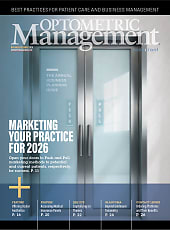WITH TODAY'S toric soft lens designs, stability has improved dramatically and many practitioners assume fittings will result in well-aligned lenses on the first try. In all reality, it quite often does. But this assumption can be costly. Overlooking even small amounts of lens rotation can lead to extended chair time and frustrated patients. Revisiting lens rotation awareness isn’t about relearning LARS (left add, right subtract), it’s about recognizing its practice management impact. Careful observation and correction can streamline efficiency and reinforce a practice’s reputation for precision.
The Old School Pearl
While familiar to most practitioners, the LARS principle is worth revisiting in context. If a toric diagnostic lens rotates to the left (from the clinician’s perspective), add that amount of rotation to the refractive axis when ordering. If it rotates right, subtract. Though simple in concept, accurate application depends on recognition of lens stabilization markings and an understanding of how rotation interacts with refractive error.
Why Rotation Still Matters
Modern lenses are more stable than ever, but “stable” doesn’t equate to perfect. Optical research demonstrates that each degree of misalignment leaves approximately 3% to 3.5% of cylinder uncorrected, meaning a 10° rotation produces ~30% to 35% loss of astigmatic correction (Ma and Tseng, 2008). This effect becomes increasingly significant as cylinder power increases:
- With 0.75 D of cylinder, a 10° misalignment typically leaves ~0.25 D residual astigmatism (Jackson, 2016). This is often tolerated, but still present.
- For 1.75 D of cylinder, 10° of rotation generates about 0.58 D residual error, or roughly a 30% reduction in effective correction (Jackson, 2016).
- For 2.25 D of cylinder and higher, even small deviations become clinically significant, often manifesting as ghosting, shadowing, or unstable clarity, since higher cylinder magnifies the visual consequences of axis error (Jackson, 2016).
These findings reinforce what seasoned fitters already know: rotation must be confirmed, not assumed.
Practical Application in Clinic
Rotation awareness for the experienced fitter is less about recalling the rule and more about disciplined execution. Allow lenses to settle before assessing rotation, interpret over-refraction in light of observed alignment, and confirm reproducibility at follow-up. For example, a plano –2.25 x 180 refraction with a toric lens that consistently rotates 10° nasally OD should be adjusted to plano –2.25 x 170. If the rotation is variable, the issue is likely design-related rather than axis-related, warranting a different lens choice.
Patient Communication
Experienced fitters know that patients can be highly attuned to even subtle fluctuations in clarity. Framing the adjustment as fine-tuning, rather than “trial and error,” underscores the precision of the fitting process. Patients appreciate knowing that small modifications are intentional and based on observed physiology, not guesswork.
Key Takeaway
Soft toric fitting has evolved, but the fundamentals endure. For the seasoned practitioner, lens rotation awareness is not merely a clinical skill, it is a practice management tool. Patients who leave with crisp, consistent vision are more satisfied and more likely to remain loyal to the practice. Applying LARS with precision reduces chair time and enhances patient confidence in your expertise. In a competitive marketplace where efficiency and outcomes drive reputation, remembering to assess and act on lens rotation is not just about optics, it is about practice success.
References
1. Ma JJ, Tseng SS. Simple method for accurate alignment in toric phakic and aphakic intraocular lens implantation. J Cataract Refract Surg. 2008;34:1631-1636. doi: 10.1016/j.jcrs.2008.04.041
2. Jackson JM. Toric lenses for today and tomorrow. Contact Lens Spectrum. 2016;31(8):28-32. clspectrum.com/issues/2016/august/toric-lenses-for-today-and-tomorrow




